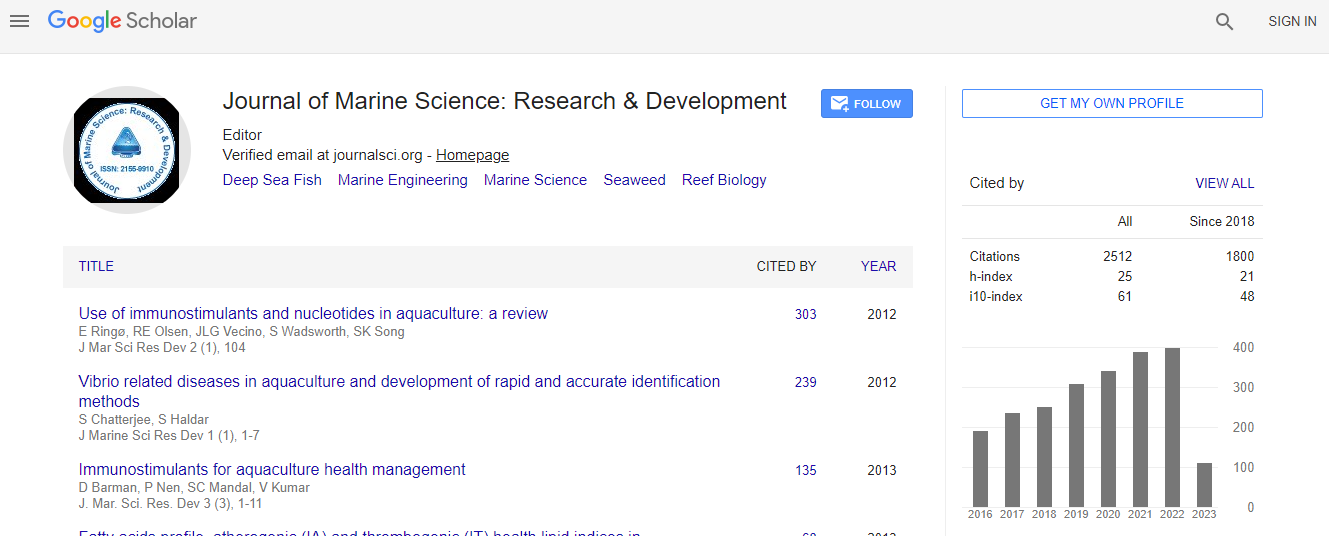Research Article
Seismic and Sequence Stratigraphic Analysis of Ewan and Oloye Fields (Middle Miocene), Northwestern Niger Delta: Implications for Deltaic Depositional Sequences
Durogbitan A Abimbola*
Petrfac IES, Research and Development, Manchester, UK
- Corresponding Author:
- Durogbitan A Abimbola
Principal Geoscientist
Petrfac IES, Research and Development, Manchester, UK
Tel: +447545822428
E-mail: adewoledurogbitan@yahoo.co.uk
Received date: May 05, 2016; Accepted date: May 16, 2016; Published date: May 23, 2016
Citation: Abimbola DA (2016) Seismic and Sequence Stratigraphic Analysis of Ewan and Oloye Fields (Middle Miocene), Northwestern Niger Delta: Implications for Deltaic Depositional Sequences. J Marine Sci Res Dev 6:197. doi: 10.4172/2155-9910.1000197
Copyright: © 2016 Durogbitan AA. This is an open-access article distributed under the terms of the Creative Commons Attribution License, which permits unrestricted use, distribution, and reproduction in any medium, provided the original author and source are credited.
Abstract
The main aim of this works is to define local sequence variability and its implications for deltaic depositional sequences within the studied area. This research work makes use of depth converted three dimensional seismic cube, well logs, core photography descriptions and biostratigraphic reports. Recognition and interpretation of stratal surfaces were based on facies shifts and stacking patterns and reflection terminations derived from the interpretation of seismic data and wireline logs integrated with core photography and biostratigraphic reports. Seismic stratigraphic analysis of well and seismic data suggests that middle Miocene- early Pliocene strata within the studied area were made of six depositional sequences. Sequences are made up aggradational to progradational HST that makes up about 50% of a sequence. TST are thin and widespread while LST are restricted to within WNWESE trending valley fills typically 4 km wide and an average 120 m deep. Outside the LST valleys, transgressive surfaces, maximum flooding surfaces and sequence boundaries are coincident on interfluves. This suggests that during LST times most of the area was periodically subaerially exposed and several incised valleys/canyons were developed. These incisions/canyons acted as a sand feeder that led to the deposition of high amplitude deposits (sandstones) on the slope and within the basin floor setting. Sequences mapped over the study area show local variation associated with growth faults. There is a strong local growth fault control on sequence variability. Further local controls on sequence geometry are shelf instability and slope scars which have a strong geomorphological impact on the area. The depth of incised valleys within the uppermost HST (up to 350 m) is difficult to explain in terms of sea level fall alone because eustatically-driven sea level variations during the Miocene are generally reported to be less than 100 m (330 ft). This suggests that the character of sequence development and depositional facies preserved within the study area depends on relative sea level changes, relative rates of regional structural collapse and sedimentation rate. The occurrence of several incisions in the middle Miocene succession is interpreted as evidence of significant relative sea level fluctuations, and the presence of type-1 sequence boundaries may be the stratigraphic signature of major drops in relative sea level during Miocene and Pliocene. Variability within the depositional sequences is said to be largely controlled by local growth faults, rapid relative sea level changes, basin physiography (shelf edge) and high rate of sediment influx.

 Spanish
Spanish  Chinese
Chinese  Russian
Russian  German
German  French
French  Japanese
Japanese  Portuguese
Portuguese  Hindi
Hindi 